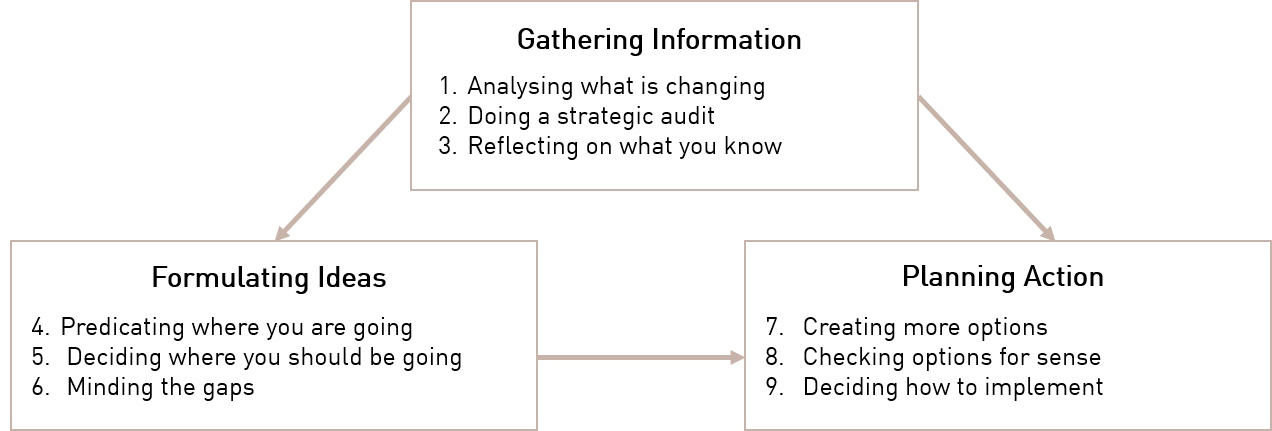Strategic thinking focuses on finding and developing unique opportunities to create value for your organisation. The term has been misused and abused in the past and too often strategic planning sessions fail to deliver any value. This can often lead to the disengagement of employees, who are the very people that boards and management need actively involved in the process.
A way of thinking
Strategic thinking is a way of approaching the fundamental drivers of a business and challenging conventional thinking. This is best done in discussions with stakeholders, with employees being a key part of this. It also involves having an awareness of what has not yet taken shape, of what might be and of what might be on the horizon. Instead of thinking ‘this is the way it’s always been done’ or ‘it’s not broken so why change?’, the mindset should be - how could we improve our processes or outcomes?
The board’s role in strategic thinking is to bring an outside perspective, accumulated wisdom and to test the consistency of management’s thinking. The role of senior management is to then, initiate the process of strategic thinking and setting the agenda by posing the questions and issues. Boards can lead the way by encouraging and modelling forward thinking, for example; supporting management to go beyond reporting on KPIs and to put forward ideas and suggestions for discussion.
Strategic thinking models
There are many models to choose from to plan your strategic thinking process. The key is to support the process, ensure that outcomes and next steps are agreed and then actioned. Otherwise, you risk remaining in a strategic thinking vortex with good ideas and no execution.
Wootton and Horne (2001), approach strategic thinking as three main activities, shown in the figure below. The gathering information and ideas generation stages are supported by the action planning stage.

Blue Ocean Strategy is another approach. This is the simultaneous pursuit of differentiation and low costs, with the aim being not to out-perform the competition in the existing industry, but to create new market space or a ‘blue ocean’, thereby making the competition irrelevant. Blue Ocean Strategy provides a set of tools to create new market space and offers a way to swim out of the red ocean filled with sharks. The strategy canvas is the central diagnostic for building a compelling Blue Ocean Strategy, which should cover both strategy formulation and execution.
Scenario planning can play a meaningful role in strategic thinking due to its focus on the future. Scenario planning explores possible futures based on forecasting changes to the competitive environment and considers what the organisation will look like in 10 or 20 years’ time. It provides a disciplined means to imagining potential futures and how these may impact organisational sustainability. Scenario planning also plays a useful role in simplifying data into a small range of possible states. Each scenario explains how different elements may interact given certain conditions and also supports creative thinking in the context of time.
The choice of strategic thinking tool or approach is up to the individual board, considering organisational size and stage. What is important is that the board recognises the need to think strategically, since it is key to the board making a meaningful contribution to the organisation’s strategy. As strategic thinking is a competency needed by all directors, it is important to evaluate whether all board members have this skill. If not, it is crucial that the board receive some training in this area.
If you would like support in direct competency in strategic thinking or to run a strategic thinking workshop, please contact our Effective Governance team.
References
Garratt, B., ed. 2003. Developing Strategic Thought: A Collection of the Best Thinking on Business Strategy. 2nd ed. London: Profile Books.
Hambrick, D.C. & Fredrickson, J.W. 2001. ‘Are You Sure You Have a Strategy?’ Academy of Management Executive, 15(4): 48-59.
Keelin, T. & Arnold, R. 2002. ‘Five Habits of Highly Strategic Thinkers.’ Journal of Business Strategy, 23(5): 38-42.
Kim, W.C. & Mauborgne, R. 2005. Blue Ocean Strategy: How to Create Uncontested Market Space and Make the Competition Irrelevant. Boston: Harvard Business School Press.
Wootton, S. & Horne, T. 2001. Strategic Thinking: A Step-by-Step Approach to Strategy. London: Kogan Page.
